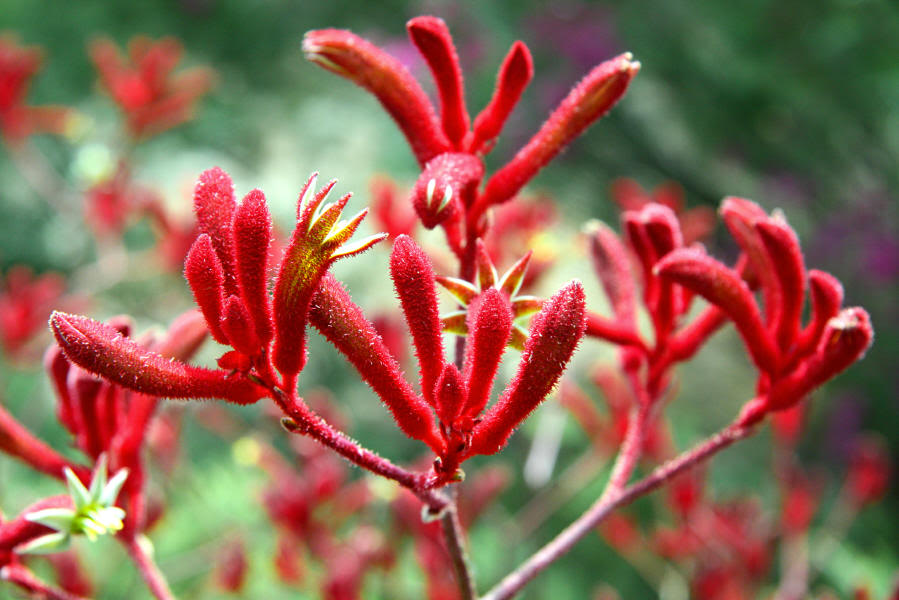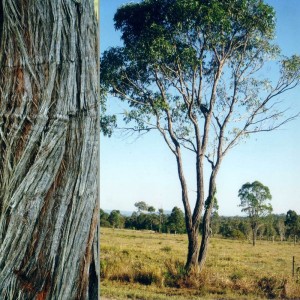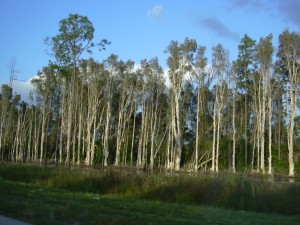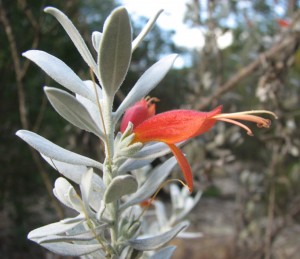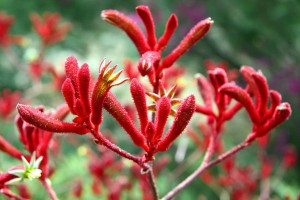Blessed with an envious abundance of varying growth environments, there are in fact about 24 000 different species of Australian native flowers and plants.
The parched desert conditions of the centre of the country may have only the sparsest and heartiest vegetation, but other areas of this majestic country are nutrient rich, lavishly hydrant and exceptionally fertile. The perfect combination of elements to bring forth wonderous plant life, vegetation and foliage. From gum trees to tomato bushes, Australia has a complete landscape of plant life to provide food, medicine and building materials.
Australia has many coastal plants and shrubs, forested areas and bush land. Different regions of the country provide unique habitats for home grown plant life. Some of the native species to Australia have often been harvested to plant in other parts of the world.
The results vary greatly when Australian plants are grown in other countries around the world. Some plant life and vegetation stubbornly refuses to grow at all outside the borders of its home and native land. No matter how well acclimatized the new environment may be to replicate familiar conditions; there are many varieties of herbs, trees, flowers and plants that will never be found in any part of the world except Australia.
Fortunately, there are just as many other plants, trees and bushes, that have discovered how to thrive away from home. Some of the most popular and well known Australian species have taken on a completely new life. These plants, trees and shrubbery are adapting to new climates, soil and water, and unusual weather conditions with such gusto that the Aussie natives have taken over the landscape, refusing to let anything else grow in the same habitat. (A regrettable example can be found in the everglades of Florida.)
Whether at home or far and away, the different species of Australian native flowers and plants are clearly among some of the most sought after flora in the world. A large number are regularly tested and studied by scientists for natural properties that promote the health and well being of other plant life, animals and even humans.
A Few of the More Well Known Species
With so many varieties of plants, it is impossible to list them all here. However, there are some very well known species that are used in different applications around the world that many people are surprised to learn are native to the soils of Australia. Names of plants, trees and flowers you hear every day may indeed be from the land down under.
Eucalyptus
When we think of eucalyptus, koalas quickly come to mind. Some varieties of eucalyptus leaves are the only food that is eaten by many types of koalas. However, the eucalyptus has a diverse amount of uses for its approximately 700 different native grown species.
Offering a humble home for a host of wildlife from birds to small animals, the eucalyptus is a variety of gum tree. The oil from the large leaves is used in many medicinal products as well as skin care and beauty products.
Vapour rub and cold remedies take advantage of this natural expectorant to bring relief to head and chest colds, to help break up nasty congestion and phlegm. Muscle creams and joint rubs also use eucalyptus because of its anti-inflammatory nature, which provides relief for both swelling and discomfort.
Eucalyptus is anti-fungal, a trait discovered by early aboriginals who used the leaves to treat wounds. It is also used as an antiseptic, or the leaves are brewed into a tea to help bring down a high fever.
As a hardwood, the eucalyptus is an icon in the Australian timber industry. As far as burning it as firewood, the fragrant aroma of eucalyptus wood on a crackling fire brings a tranquil serenity unmatched by other burnable woods. The pleasant scent of the eucalyptus can be found in many other products used around the home, unmistakable and distinct as an Australian classic.
Melaleuca Trees
Not quite that familiar with the melaleuca tree? It comes in a variety of sizes from the very large 80 foot trees to smaller ones that are merely a few feet off the ground. Quite likely everyone in Australia is familiar with this densely populated native tree, but in other parts of the world, this tree is known by different aliases.
Sometimes called the paperbark tree, the smaller melaleucas are best known throughout the world as tea trees. The oil from the tea tree is among the most widely used natural essential oils in the world. Now have you heard of it?
Anti-fungal, anti-inflammatory, anti-viral and antiseptic, the medicinal uses of tea tree oil are still being discovered and expanded upon practically every day. The natural healing properties can be found in skin care products, antiseptic washes, shampoos, body washes, skin creams and even toothpaste and mouthwash.
In recent years, tea tree oil has been singled out as a natural, non-pesticide treatment to get rid of head lice. Although there has not been enough scientific research conducted to verify how and why this appears to work, parents around the world swear by it.
Eremophila
While many of Australia’s native plant life is often cultivated to grow in other parts of the world, the eremophila is quite loyal to its homeland. There are perhaps 214 different varieties of the eremophila, all of which can be found exclusively in Australia.
Also known as emu bushes, the oil from this tree is another popular essential oil. Emu oil has a wide variety of uses but its most commonly used as in topical skin care products. Known for its intense rehydrating properties, emu oil is a favourite ingredient in natural body washes, shampoos, soaps and lotions.
Kangaroo Paws
This lovely plant is an Aussie relative of the lily family, whose scientific name is haemodoraceae. Over 100 species are in this variety of small plants, which have leaves that stretch out about 3 feet high and wide. The plant earned the name kangaroo paws because of the pretty flower bells, which are long and slim, looking very much like the paws of a kangaroo. The flowers do not carry much of an aroma, but are quite pleasing to view and ideal for certain types of birds.
Other Flowering Plants
Australia has a huge selection of beautiful flowering plants that are often cultivated in gardens around the world. Bright, vibrant colours, delightfully shaped petals and hearty growth make many of the native flowers of Australia a gardener’s paradise.
Many of Australia’s plants and flowers make great features in the garden, while others are planted to attract butterflies or birds. With so many flowers, there is hardly a lack of choice for adding colour and texture to any display.
Some popular flowers include several members of the mint bush, such as the seven different species of the hemiandra and forty varieties of hemigenia, all of which are exclusive to Australian soil.
In fact, for almost every major plant family, there are at least a few varieties that can only be found and grown in Australia. Daisies, acacia, hakea and many flowering pea plants are native to the country and keep their roots planted in home soil.
Weeds are Plants Too!
What is a garden without a few weeds? Plant life in Australia has many beautiful blooms and lush forestry, but it also has some rather interesting weeds. Many of the plants that were considered flowers a couple centuries ago are now in the weed category.
Keep in mind, a weed is a plant that has no purpose. No fragrance to enjoy; no beauty to admire; no benefit to the soil. Sometimes weeds are a magnet for other undesirables such as plant-destroying insects. James Russell Lowell once referred to weeds as “no more than a flower in disguise.” In the case of many of the weeds found in Australia, that is a fitting description.
Several types of plants in the wattle family such as cootamhundra, golden wreath and queensland silver, have grown too dominant to be considered anything other than a weedy nuisance. Even some species of melaleuca have overgrown their welcome is some areas around Victoria, making them treacherous to other plants trying to grow in the bush.
Interestingly enough, some of the plants that originated in Australia and were harvested and seeded in other parts of the world, have become to overbearing for their host environment and been classed as weeds. Therefore, anyone looking to plant an Australian garden would be wise to avoid planting acacia, melaleuca, a.cyclops and other native Aussie plants. These are among many of the greeneries that are so adaptable to new environments that they become dominant to the point they bring peril to the growth of other plants.
Fire Proof Plant Life
The threat of bush fires is ever dominant in many parts of the Australian landscape. Most plants and bushes will burn quickly and spread easily to others in their path. However, there are some very hearty plants, both native and non-native, found in Australia that stand tough in the face of fire.
That does not mean these plants will never burn at all. It means numerous studies and tests have been performed to see how resistant they are to burning. Fire resistance means it takes a longer time for the plant to ignite. Due to their natural ability to withstand the heat, Australians in high risk fire areas are recommended to plant these varieties around their property. Plants will not stop the fire from reaching a person’s home, but it might slow it down enough to reduce the damage.
Some of the fire proof Australian plants recommended for planting include many types of saltbush, including coast saltbush, spreading saltbush, silver saltbush, old-man saltbush and several others. Rounded noon-flower, creeping emu, bottle bluebush, frosted goosefoot, white cedar as well as all twin leaf plants have been tested and found suitable for fire prone areas.
Ground cover is just as important to keep a fire from spreading, and there are many plants recommended that help keep the fire from engulfing the area. Silver mulga, narrow rock-fern, spotted gum, silver wattle, water bush, blackwood and dozens of other low growing ground plants will not burn when the first contact with fire reaches them. However, due to the nature of fire, these plants will very likely lose all their moisture content during a fire, at which point, the dried leaves will become vulnerable to flame.
Australia’s Garden of Delights
An intricate source of pride for so many, the many botanical wonders that cast themselves upon the landscape are a treasured garden of delights. Very few countries can boast so many native specimens. By comparison, England is barely a garden country at all, with only about 1700 different plants that are native to the country. Of-course, finding new, undiscovered plant life in Australia’s vast forests and bush land does happen from time to time.
Will there ever be an exact number? It is highly unlikely. Some species have become endangered due to environmental changes. Fires have greatly reduced some fragile greenery, and the introduction of non-native plant life over the centuries has pushed out some weaker native species.
Nevertheless, Australia will continue to be one of the best places to look at when it comes to finding variety, colour, fragrance and diversity in all forms of plant life. Scientists will continue to explore the vast properties and characteristics of different vegetation to bring new medicine to the human race.
We are majestically humbled when we look at the immensity of the different species of Australian native flowers and plants. Indeed, it does make the human race rather insignificant by comparison.
Whether strolling by the garden gate, resting beneath a shady tree with a good book, or filling the air with aromatic presence of eucalyptus, there is no part of the world that has not been touched, changed and made better by the wonder of Australian plant life.
Useful links:
Australian flora | australia.gov.au
Australian Native Plants Society (Australia)
Florabank
Greening Australia
Planting the Seeds of a Healthy Environment
